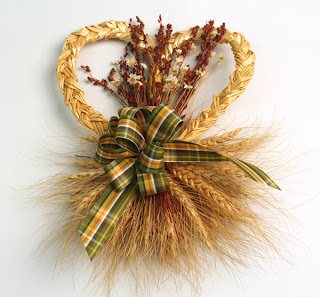Objective enhance collection Label!
Label (Green Indicates changes/additions)A wheat weaving,called a "Mordiford".The term mordiford refers to ultimate shape of the woven wheat. The stalks of the plant are soaked in water until they are pliable. After soaking the stalks they are plaited into a heart shape with the seed ends fraying out at the end.# In this particular example the, wheat hangs at the bottom, above wheat stems are woven together into a heart. Green plaid bow and dried flowers are attached in the center. Wheat weaving originated as a celebration of the Harvest. In the sixteenth century, the English wove the crop to represent the spirit of Harvest Time. The use of straw as a material was wonderful for baskets, hats and other forms of storage or decorative pieces. From the seventeenth century forward, it became a homemade industry that provided families with income and employed thousands outside of the home. By the nineteenth century the crop token had become commonalty throughout Europe. The skill of weaving straw and wheat was a skill that European families brought with them too America. However with the advent of modern industry and machinery the use and knowledge of this craft became virtually non-existent. Arts and crafts revivals throughout the mid twentieth century however brought this talented skill back to life.# Today to protect the wheat weaving craft is the National Association of Wheat Weavers or the NAWW. Founded in 1987 the objective of this organization is to “educate, develop, all forms of straw artistry, and to Preserve and perpetuate the history and traditions associated with the folk art of corn dollies, wheat plaiting (also known as wheat weaving) and other forms of straw art.”#. This particular piece was made by artists and donors, Ingrid Jonsson a graduate of Michigan State University, class of 1967# and May-Britt Eklov. It measures 10" x 7". Made in Michigan. Swedish.
- Diane, Sister. "Made Me a Mordiford!" CraftyPod. Wordpress, 27 June 2008. Web. 01 Dec. 2012. <http://www.craftypod.com/2008/06/27/made-me-a-mordiford/>.
- About Straw Art." The National Association of Wheat Weavers. NAWW, n.d. Web. 01 Dec. 2012. <http://nawwstraw.org/index.php/about-straw-art>.
- "About the National Association of Wheat Weavers." National Association of Wheat Weavers. N.p., n.d. Web. 01 Dec. 2012. <http://nawwstraw.org/index.php/about-naww>.
- "Ingrid Jonsson." Classmates. N.p., n.d. Web. <Classmates.com>.


